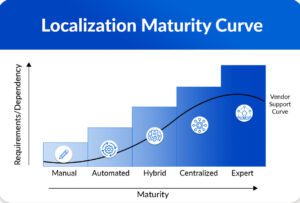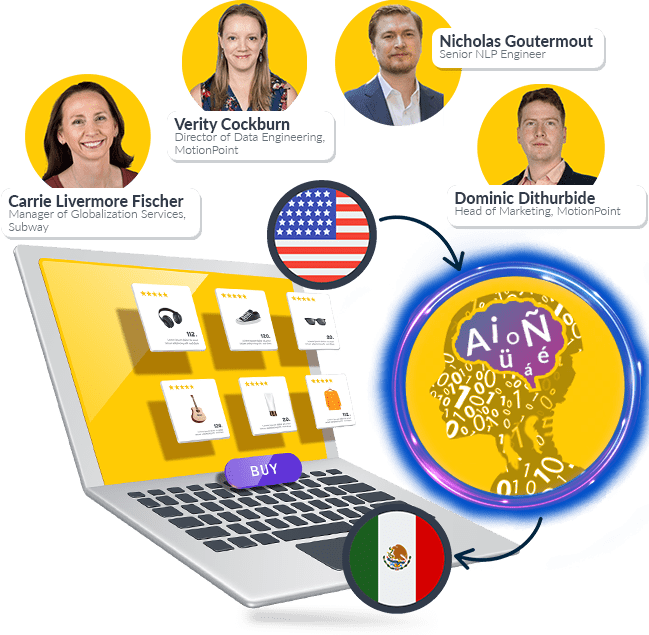What Is the Translation Lifecycle of a Company?
Global expansion is one of the most impactful and effective ways to grow a business. As a result, many companies rely more and more on translation and localization of content to expand. To do both requires planning and consistency, which can be difficult for a business to handle on their own.
The translation lifecycle of a company is directly related to the localization maturity curve. Each of the five phases of the localization maturity curve has a strategic process in place to move a company to the next level, until full localization is reached.

The entire translation life cycle requires a lot of communication and collaboration with others for successful results. As a company becomes more mature and requires higher levels of international dependency, the more support is needed from a language services vendor such as MotionPoint increases.
Here are the phases of localization:
Phase 1: Manual
The Manual phase applies to companies that are most likely just beginning their international expansion journey and do not have translated content on their website. During this phase, international maturity and international requirements are low, and translation processes are unpredictable and ad hoc - most translations are manual and are chosen for specific use cases. There's no centralized approach to handling translations, which can leave businesses vulnerable to lose market share to better organized competitors.
Phase 2: Automated
The Automated phase occurs during a low level of international maturity and international requirements. Some translation automation tools may be leveraged to perform translation projects. This can include machine translation solutions such as Google Translate. Perhaps business is manually translating ads and blog content, which are beginning to gain some traction in the marketplace. This is the phase where a business may want to start translating to scale and increase visibility among the target audience.
Phase 3: Hybrid
As your international maturity grows, so do your international requirements. You may find your business needs to translate content into more languages and think about integrating localization rather than simply translating. The Agile phase refers to the agile methodology of working in sprints. Each translation and localization project can be considered a "sprint" and encompasses more than plugging text into a machine translation program. All elements of a company brand and website needs to be localized in (possibly) different languages and requires a process of doing so effectively over and over. In this phase, translation technology is well-defined. A business can use standard tools and have defined roles to ensure that localization is appropriately prioritized. Most importantly, metrics can be created to rate future performance.
The Agile phase is where the vendor support curve is the steepest. At this point, it's recommended to hire a translation and localization company like MotionPoint to ensure translation and localization projects are handled efficiently and effectively.
Phase 4: Centralized
The Centralized phase occurs when translated languages are well-established and the bulk of the translation and localization adjustments are taken care of by a dependable, centralized entity, such as MotionPoint. Since most or all of a company's translation and localization content is in place, translation memory software will automatically take care of updating preexisting words and phrases. Continuous translation will ensure website content is accurately updated in a timely manner as the company continues to grow.
Phase 5: Expert
In the Expert phase, a business is considered to be at peak international maturity and international requirements or dependencies. Depending on the size and nature of a business' website, it may make more financial sense to build a translation and localization team in-house. However, there are drawbacks to building an in-house team. In-house teams can result in numerous hidden costs related to employing a full staff or additional resources to handle translations, and it can drain the time of existing staff as responsibilities related to translation are added to their workload. An in-house translation team also leaves projects open to time creep and incurs the opportunity cost of latency in go-to-market indefinitely.
Understanding the Total Cost of Ownership in the Localization Lifecycle
As businesses progress through the phases of the localization maturity curve, it's essential to consider the total cost of ownership (TCO) associated with their translation and localization efforts. TCO includes all direct and indirect costs incurred throughout the lifecycle of a translation project, from the initial setup to ongoing maintenance and updates. Understanding these costs can help businesses make informed decisions and optimize their localization strategies. The maturity stage your company is in significantly influences these costs.
TCO Factors for Phase 1: Manual
At the Manual phase, the direct costs are relatively low because the volume of translation work is minimal. However, indirect costs can be high due to the lack of streamlined processes:
- Direct Costs: Limited to ad hoc translation fees for specific projects.
- Indirect Costs: High due to inefficiencies and the absence of translation management systems. Staff may spend a disproportionate amount of time on managing these initial projects.
TCO Factors for Phase 2: Automated
In the Automated phase, the investment in automation tools begins to impact TCO:
- Direct Costs: Moderate, as businesses start using machine translation solutions and basic translation management tools. Translation fees might decrease slightly due to automation.
- Indirect Costs: Remain significant as the company learns to integrate these tools effectively. Project management and quality assurance processes still require considerable manual effort.
TCO Factors for Phase 3: Agile
As companies move into the Agile phase, the complexity and volume of their translation needs increase, affecting both direct and indirect costs:
- Direct Costs: Increase due to the need for more sophisticated translation and localization technologies and potentially higher translation fees for more languages and specialized content.
- Indirect Costs: Project management becomes more efficient with defined roles and processes, but the need for continuous coordination and quality assurance remains.
TCO Factors for Phase 4: Centralized
In the Centralized phase, companies experience a shift in cost dynamics due to centralized management and automation:
- Direct Costs: Higher initial investment in advanced translation management systems and professional translation services. However, the use of translation memory software helps in reducing repetitive translation costs.
- Indirect Costs: Decrease significantly as the process becomes streamlined and centralized. Project management and quality assurance are more efficient, reducing the time and resources required.
TCO Factors for Phase 5: Expert
At the Expert phase, TCO considerations become crucial as companies weigh the benefits of in-house teams versus continued reliance on LSPs like MotionPoint:
- Direct Costs: Potentially high if building an in-house team, including salaries, benefits, and training. Alternatively, partnering with an LSP can provide predictable and scalable costs.
- Indirect Costs: In-house teams can lead to increased hidden costs related to operational inefficiencies and resource allocation. LSPs like MotionPoint can mitigate these by offering comprehensive services and expertise.
Optimizing TCO with MotionPoint
MotionPoint helps businesses optimize their TCO by providing comprehensive translation and localization services tailored to their needs at each phase of the localization maturity curve. By leveraging MotionPoint's expertise, businesses can:
- Phase 1-2: Reduce direct costs through competitive pricing and efficient use of automation tools.
- Phase 3: Minimize indirect costs by streamlining project management and quality assurance processes.
- Phase 4-5: Avoid hidden costs associated with in-house teams by utilizing scalable and specialized LSP services.
In summary, the phase of the localization maturity curve you are in directly dictates the different cost factors of your translation and localization efforts. MotionPoint's end-to-end services provide a clear path to minimizing costs and maximizing value throughout the translation lifecycle.
结论
No matter what phase you’re in on the localization maturity curve, considering the total cost of ownership is vital. With the right strategies and partners, businesses can navigate the complexities of global expansion efficiently and cost-effectively. MotionPoint offers tailored services to help you achieve your international goals while optimizing your investment in translation and localization.
最后更新日期:2022年12月27日

